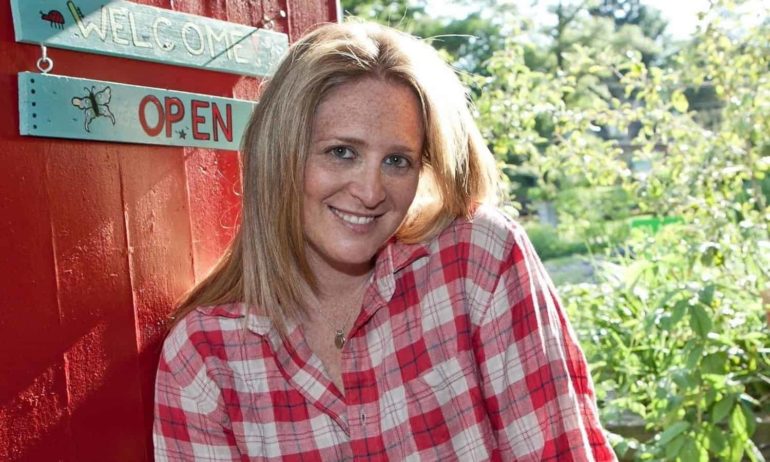Lovin’ Spoonfuls is a Boston-based organization rescuing and distributing fresh, healthy food that would otherwise be discarded—totaling more than 900,000 kilograms (2 million pounds) since it was founded in 2010. Food Tank had the opportunity to speak with Ashley Stanley, Founder and Executive Director.
Food Tank (FT): What is the inspiration behind Lovin’ Spoonfuls (LS)?
Ashley Stanley (AS): LS is a pragmatic extension of what I think is a common reaction to food waste: why can’t we get excess food to people who need it? There is a lot in the world that needs fixing, and the solutions at present seem incredibly unattainable. LS breaks down the wrong notion that not enough food is produced, grown, harvested, and retailed. We work hard to change the way we think about food as we focus on distribution and access. Learning that food is the second largest component of the waste stream was an environmental wake-up call, too. As food rots in landfills, it emits methane, a gas 27 times more harmful than carbon dioxide. We are throwing away football stadiums worth of food every single day. Our food waste problem holds a powerful role in our resource supply, depleting both our water supply and our oil supply. On top of all of this, the retail value of wasted food is over US$165 BILLION. Wasting food the way we do is the most unnecessary problem we have on the planet.
FT: Can you tell us the differences between a food rescue organization and a food bank? Are there areas of overlap?
AS: Food rescue organizations focuses on distribution, including the capture of the excess when food is deemed not marketable, then upcycling it. Most often, these organizations are mobile entities, getting the food from where it is to where it needs to go. Often (and in the case of LS exclusively), you are dealing with highly perishable products, making distribution the priority. Food banks have long been a mainstay of hunger relief, providing access to products that are predominantly shelf-stable to people in need. They are necessary, especially in these times of growing population and intense economic insecurity. Rescue organizations deal with products already in the retail stream while food banks traditionally distribute products originally intended for donation. The difference is really in distribution and access. People go to a food bank for access and are often given pre-approved and pre-allotted allowances of food for themselves, their families, and more increasingly, social service agencies. A food rescue, or at least with our model, is strictly direct distribution; purposely meant to streamline access and reduce the custody chain.
FT: The model seems simple but effective in fulfilling the mission of LS; yet, this is the first time I, and perhaps others, heard of the “food rescue” concept. Is the concept of rescuing food, especially at the level of a nonprofit organization rather than at the level of an individual, a new one?
AS: No, not at all. The concept of food rescue, or food recovery, has been around for generations. It is the basic concept of waste not, want not. In other words, when there is plenty, let no one go hungry. Food is an opportunity. How do we extend that opportunity? The world continues to evolve through innovations in technology, soaring population growth, and massive developments in food production; creating an opportunity to maximize efficiency within the food system. Food rescue as a viable and real solution is becoming more about protecting our food supply and creating accountability within the waste-stream. The information available about our food supply, our food system, our growing practices, and the tremendous consequences of wasting food has catalyzed a movement of people asking, ‘What can we do about this?’ Our model focuses on legitimizing rescue and recovery, not only as a feel-good proposition but also as a triple-bottom-line solution. Our model utilizes temperature-controlled vehicles at all times, systemized practices geared towards vendor and beneficiary service, digitally regulated inventory systems, and full-time employees. The volunteer movement is fantastic and necessary. In this space, it is critical to ensure consistency, sustainability, and focus on the health of the food.
FT: This call to bridging the gap between abundance and want comes at a time of eating contests and restaurant advertising attractions of “the biggest plate of food”. What do you think is the first step to shifting this culture of “big” food?
AS: Let’s reframe the way we think about food. Let’s reframe the way we think about need. Let’s reframe the way we think about access. Hunger is not about ‘not enough’; it is about distribution. Here we are in this wealthy country, but our food continues to lose its value. Its value now lies in how it looks, how it is photographed, in its entertainment worth. All of those are fun and fantastic parts of a rich and vibrant food culture. But let’s not forget that food is a human necessity and a human right. It is a basic need, a basic essential that human beings require to survive. Let’s put the value of food back. Let’s see food as our most powerful tool to unite and connect community rather than to separate and divide it based on wealth and status.
FT: What are some tips for individuals to reduce food waste?
AS: Plan ahead! Making food as a point of conversation is essential. Not everyone has the time to make multiple trips to the grocery store or farmer’s market, but we can be more strategic in the way we shop for food. I love leftovers; I usually have a few different ideas to make ingredients go further. Get your kids involved; make it fun and creative where it’s possible. The average American wastes US$336-US$516 each year with food that never gets prepared, cooked, or made into a second meal. That’s a lot of food and money!















